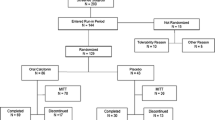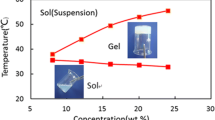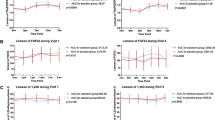Summary
Studies were carried out to determine whether monolithic depot formulations, prepared using lactide:glycolide copolymers, could be used to administer salmon calcitonin (sCT) to rats in vivo. Formulations containing 2, 5, or 10% (w/w) sCT were administered subcutaneously to female Wistar strain rats. Release of sCT was determined by measurement of peptide in plasma using a specific radioimmunoassay and by measurement of residual sCT in the depots after recovery at postmortem. Plasma calcium concentrations and cumulative weight gain of the animals were used to measure pharmacological effects of the released sCT. Release of sCT from the depots was controlled by the copolymer and was sustained for periods up to 10 days. However, the release of sCT from the depots did not significantly alter plasma calcium concentrations, and effects on cumulative weight gain were small and transient. Peptide loading of the formulations was shown to modify sCT release. Maximal release of sCT from depots containing 10% peptide occurred over a 7 to 14-day period postadministration, with 5% sCT release occurred between days 11 and 14, and with 2% sCT, the period of maximal release was between days 11 and 18. Release of peptide from the depots was essentially complete by 21 days postadministration irrespective of the peptide loading. These data suggest that lactide:glycolide copolymer depots may have application for the convenient clinical administration of sCT in metabolic bone diseases.
Similar content being viewed by others
References
Talmage RV, Cooper CW, Toverud SV (1983) The physiological significance of calcitonins. In: Peck WA (ed) Bone and mineral research annual 1. Excerpta Medica, Amsterdam, pp 74–143
Chambers TJ, Magnus CJ (1982) Calcitonin alters behaviour of isolated osteoclasts. J Pathol 136:27–39
Thamsborg G, Storm TL, Sykulski R, Brinch E, Nielsen HK, Sorenson OH (1991) Effect of different doses of nasal salmon calcitonin on bone mass. Calcif Tissue Int 48:302–307
Reginster JY (1991) Effect of calcitonin on bone mass and fracture rate. Am J Med 91 (suppl 5B):19S-22S
Huwyler R, Born W, Ohnhaus EE, Fischer JA (1979) Plasma kinetics and urinary excretion of exogenous human and salmon calcitonin in man. Am J Physiol 236:E15-E19
Nagant-de-Deuxchaisnes C, Devogelaer JP, Huaux JP, Dufour JP, Esselinckx W, Engelbeen JP, Stasse P, Hermans P, de Buisseret JP (1987) New modes of administration of salmon calcitonin in Paget's disease: nasal spray and suppository. Clin Orthop 217:56–71
Overgaard K, Christiansen C (1991) Long-term treatment of established osteoporosis with intranasal calcitonin. Calcif Tissue Int 49(S):560–563
Thiebaud D, Burckhardt P, Jaeger P, Azria M (1987) Effectiveness of salmon calcitonin administered as suppositories in tumor-induced hypercalcemia. Am J Med 82:745–750
Angelini GP, Gonnelli S, Palmieri P, Agnusdei D, Vassellatti D, Gennari C (1992) Effect of salmon calcitonin given by suppositories on bone mass in osteoporotic patients: a double blind controlled study. Bone Miner 17(S):A394
Overgaard K, Agnusdei D, Hansen MA, Maioli E, Christiansen C, Gennari C (1991) Dose-response, bioactivity and bioavailability of salmon calcitonin in premenopausal and postmenopausal women. J Clin Endocrinol 72:344–349
Fukunaga M, Miller MM, Deftos LJ (1990) Factors affecting the enhanced hypocalcemic action of liposome-entrapped calcitonin. Calcif Tissue Int 47:373–377
Lee KC, Soltis EE, Newman PS, Burton KW, Mehta RC, DeLuca PP (1991) In vivo assessment of salmon calcitonin sustained release from biodegradable microspheres. J Cont Release 17:199–206
Obie JF, Cooper CWJ (1979) Loss of calcemic effect of calcitonin and parathyroid hormone infused continuously into rats using the Alzet minipump. Pharm Exp Ther 209:422–428
Hutchinson FG, Furr BJA (1990) Biodegradable polymer systems for the sustained release of polypeptides. J Cont Release 13:279–294
Chodak GW (1989) Luteinizing hormone-releasing hormone (LHRH) agonists for treatment of advanced prostatic carcinoma. Urology 33:42–44
Kumar MA, MacIntyre I (1965) A biological assay for calcitonin. J Endocrinol 33:469–475
Hutchinson FG (1982) Continuous release pharmaceutical compositions. Eur Patent Appl 58,481, August 25, 1982
Churchill JR, Hutchinson FG (1985) Continuous release formulations. US Patent 4.526,938, July 2, 1985
Gindler EM, King JD (1972) Rapid colorimetric determination of calcium in biologic fluids with methyl thymol blue. Am J Clin Pathol 58:376–382
Author information
Authors and Affiliations
Rights and permissions
About this article
Cite this article
Millest, A.J., Evans, J.R., Young, J.J. et al. Sustained release of salmon calcitonin in vivo from lactide: Glycolide copolymer depots. Calcif Tissue Int 52, 361–364 (1993). https://doi.org/10.1007/BF00310200
Received:
Revised:
Issue Date:
DOI: https://doi.org/10.1007/BF00310200




